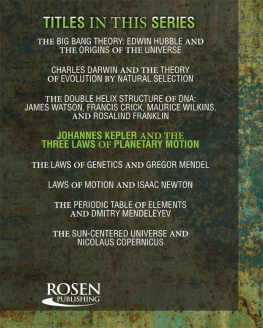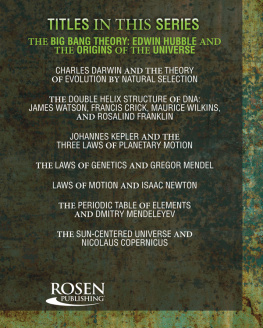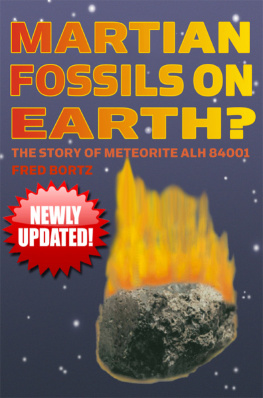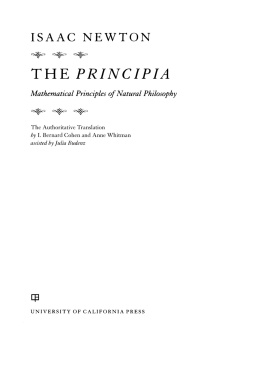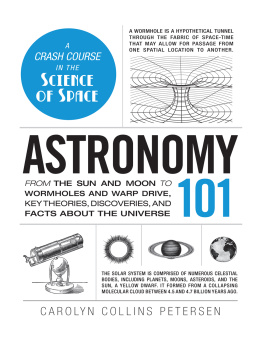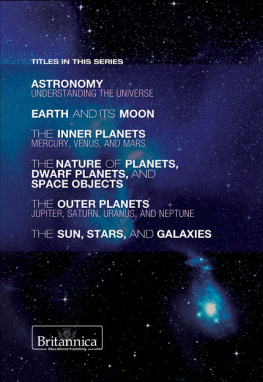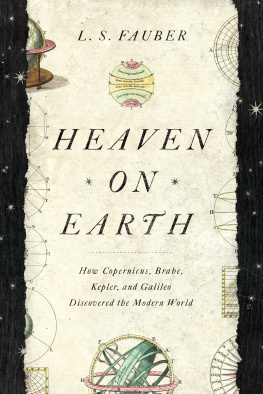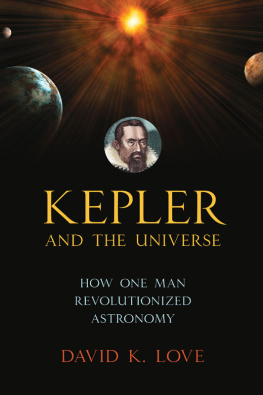

Published in 2014 by The Rosen Publishing Group, Inc.
29 East 21st Street, New York, NY 10010
Copyright 2014 by The Rosen Publishing Group, Inc.
First Edition
All rights reserved. No part of this book may be reproduced in any form without permission in writing from the publisher, except by a reviewer.
Library of Congress Cataloging-in-Publication Data
Bortz, Fred, 1944
Johannes Kepler and the three laws of planetary motion/Fred Bortz.
pages cm.(Revolutionary discoveries of scientific pioneers)
Includes glossary.
Includes bibliographical references and index.
ISBN 978-1-4777-1805-6 (library binding)
1. Kepler, Johannes, 15711630. 2. AstronomersGermanyBiography.
3. Keplers laws. 4. Planetary theory. I. Title.
QB36.K4B639 2014
521'.3dc23
2013011700
Manufactured in the United States of America
CPSIA Compliance Information: Batch #W14YA: For further information, contact Rosen Publishing, New York, New York, at 1-800-237-9932.
A portion of the material in this book has been derived from Kepler and the Laws of Planetary Motion by Heather Hasan.
CONTENTS
CHAPTER ONE:
SIGNS OF BRILLIANCE
CHAPTER TWO:
TURBULENT TIMES
CHAPTER THREE:
EARTHS PLACE IN THE UNIVERSE
CHAPTER FOUR:
RIVALRY AND TRIUMPH
CHAPTER FIVE:
THE MATHEMATICS OF KEPLERS LAWS
CHAPTER SIX:
KEPLERS OTHER ACCOMPLISHMENTS AND
MODERN SCIENCE
INTRODUCTION
A s long as there have been civilizations on Earth, people have watched the skies with wonder. And wonder led to profound questions: What are those lights, both great and small? What makes them move the way they do? When and how did they come into being? Are they part of our world or separate from it?
Before there was science, ancient civilizations answered those questions with religion, stories, and myths. The sun became the greatest of all gods and ruled the day. The moon was a lesser god and ruled the night along with the stars.
Each civilization noticed that all the stars except five wanderers (which we now call the planets Mercury, Venus, Mars, Jupiter, and Saturn) moved together in patterns that we call constellations. The motions of the sun, the moon, and the planets took them across a set of constellations that formed a circle around the sky. We now call those constellations the zodiac.
The ancients noticed that the moon went through its phases in about twenty-nine days, during which it also moved through the zodiac. The suns movement through that circle took much longerabout 365 days, and the seasons cycled once during that time.
The planets motion was more complex. Each moved at its own speed and sometimes reversed direction and performed a loop before resuming its usual east-to-west path. The planets, too, were usually considered gods, as were the constellations.

JOHANNES KEPLER, SHOWN HERE IN THIS 1610 OIL PORTRAIT, LAID THE FOUNDATION FOR MODERN PLANETARY ASTRONOMY. HIS PRECISE OBSERVATIONS AND ANALYSIS LED TO THREE MATHEMATICAL LAWS THAT PRECISELY DESCRIBED THE ORBITS OF THE PLANETS, INCLUDING EARTH.
Because of modern science, we can now explain all those heavenly motions. We know that gravity holds the planets in orbit around the sun. We know that the sun is a star and that Earth is a planet in orbit around that star.
We can compute where the planets were in the sky at any time in history and where they will be at any time in the future. We can do the same for any other body in the solar system and any body in orbit around Earth or any other planet.
We can make those computations using a set of mathematical laws first recognized by a great astronomer and revolutionary thinker named Johannes Kepler.

W hen Johannes Kepler was born in the small town of Weil der Stadt, in Wrttemburg (now part of Germany), on December 27, 1571, the world, and especially Europe, was experiencing a period of great intellectual and social change. Protestant churches were challenging the religious and political dominance of the Roman Catholic Church. In science, leading astronomers were challenging Earths central position in the universe.
No one could have predicted that Johannes, the firstborn child of Heinrich and Katharina Kepler, would grow up to be an astronomer, let alone challenge another idea central to both religious and scientific thinking: that the motion of each planet could be described by an interlocking set of perfect circles that turned at constant speeds.
He would replace each planets set of circles with a single curved path and would develop mathematical formulas that related the sizes of those paths and speeds of all the planets in precise and simple ways. That curve and those formulas have been known ever since as Keplers laws of planetary motion.
KEPLERS EARLY YEARS
Johannes had a challenging childhood. His family had once been part of the nobility. However, their property, wealth, and status had dwindled over the generations, leaving the family poor. To earn a living for his family, Heinrich Kepler left them on several occasions to become a mercenary, or a paid soldier, for various religious causes. He left home when Johannes was five and only returned briefly and infrequently. Heinrich left the family for the last time when Kepler was in his late teens and is said to have died somewhere in the Netherlands.
Young Johannes lived with his mother, Katharina, at his grandfathers inn. Despite his young age, he was put to work there waiting tables. He often struggled with poor health. He suffered from stomach problems and often got rashes and boils on his skin. He was also nearsighted and had double vision, possibly caused by a near-fatal case of smallpox that he had suffered as a small child.
Despite those difficulties, he also had fond childhood memories that probably inspired him to become an astronomer. One of his earliest recollections was of a dark night in 1577 when his mother woke him and brought him to a nearby hillside to see a brilliant comet in the sky. On another clear night in 1580, his mother took him out to view a lunar eclipse. He watched the moon darken and then brighten as Earths shadow passed across it.

KEPLER WAS BORN IN THE TOWN OF WEIL DE STADT, GERMANY, WHERE THIS MONUMENT NOW STANDS TO HONOR HIS PROMINENT ROLE IN THE HISTORY OF ASTRONOMY.
Despite poverty and illness, Johannes was a gifted student. The Kepler familys move from Weil der Stadt to the nearby town of Leonberg gave young Johannes greater educational opportunity. At the German Schreibschule in Leonberg, his teachers recognized that he was much brighter than the rest of the boys. They sent him to a Latin school to prepare him for university. At the Latin school, Keplers instructors taught him so well that, for the rest of his life, he spoke and wrote clearly and beautifully in Latin. His German, however, was clumsy and confused.
His education was interrupted for a year when his grandfather decided that the boy had received enough education and put him to work as a dishwasher. His teachers begged his grandfather to let him return to school. Thankfully, the grandfather agreed.

